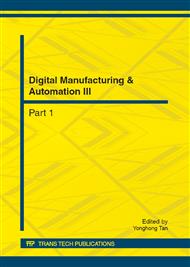p.1331
p.1336
p.1340
p.1345
p.1351
p.1355
p.1361
p.1365
p.1371
Disquisition of Testing System for BMBS Vacuum Booster
Abstract:
To solve the problem of testing BMBS (BLOW-OUT MONITORING AND BRAKE SYSTEM) vacuum booster performance, a double-station and on-line test system for BMBS vacuum booster was designed. It adopts high-speed data collection method and computer control technology. This system can test the performance in non-BMBS condition and BMBS condition. The test items mainly include dynamic characteristic and sealing performance under each condition. The double stations are independent and have no interference with each other. The system fills up the blank of performance testing about BMBS vacuum booster. To verify this system, experiments were conducted with the vacuum booster which installed the BMBS technology. The experiment results show that the system can do well in testing the performance of BMBS vacuum booster in high precision. The sealing performance resolution is 0.01kPa and the pressure resolution is 1N.
Info:
Periodical:
Pages:
1351-1354
Citation:
Online since:
July 2012
Authors:
Price:
Сopyright:
© 2012 Trans Tech Publications Ltd. All Rights Reserved
Share:
Citation:


